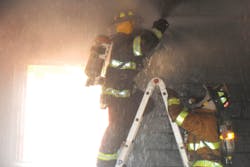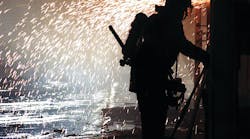Your department has recently brought on new members, and they have arrived at your fire station. New faces that are anxious to join the ranks of the future leaders of the service we have come to embrace and respect. Some enter through a testing and hiring process, some join the ranks through a recruitment drive, and some come aboard through a friend’s suggestion and incentive.
No matter how they arrived, they all have one thing in common, as we did when we entered; our first exposure to the service comes from the fire station. This initial period of exposure to firehouse life can be extremely influential on the candidate. Moreover, new members may be going through some in-house training before the start of a new recruit class. It is critical that some vital information be passed unto them before they enter the academy doors. Here are a few points of wisdom for consideration:
1. Your personal protective equipment (PPE) will save your life - Nationwide, studies show that most injuries can be traced back to the user not wearing all of their PPE, or wearing it incorrectly. So, experienced firefighters and officers should make good use of this valuable time and train the members in how to properly wear their PPE (see Photo 1). By the time they get to the academy, knowing what their gear is used for and how to don it quickly will improve their safety on the training grounds as well.
2. Learn to control your emotions - There will be times during the recruit class that the candidate will be pushed to the limit, both physically and emotionally. It is all part of the process to prepare them for working on the fireground. They will be seeing the citizens they protect having one of the worst days of their lives; being able to keep their emotions in check will aid in providing for a confident and efficient response to their emergency.
3. Find a mentor within the department - Being a candidate within the service usually provides more questions than answers. Having an experienced firefighter to help show them the way towards success will pay dividends; not only will it improve their confidence at the academy, it will help to develop a better “product” at the end of the training process, and the department will directly benefit from it.
4. Work on conquering your fears - Candidates will have significant apprehensions before arriving at the academy, but some fears are more significant than others. Specifically, candidates that are afraid of heights, or are claustrophobic, can have debilitating effects on the success of the candidate. Starting the process of having the candidates climb ladders and wear their self-contained breathing masks will begin to build the confidence they need.
5. Get your hands on the power tools - Many academy classes involve training with power tools, fans, and hydraulic powered equipment. These units require some strength and skill to start, operate and control (see Photo 2). Moreover, most academy lessons will not provide an adequate amount of time for students to become as proficient as needed on the unit. Getting some hands-on time in-house will help to build efficiency and proficiency.
6. Setbacks are common, do not get discouraged - Most of the skills and techniques that are taught at the academy are new to the candidate; the fact is that everyone makes mistakes. This is exactly what the time at the academy is for… practice. Candidates should take as much opportunity as they can to focus on the hands-on skills that they feel they are weakest at (see Photo 3). The training setting is supposed to be designed to anticipate errors and miscues from the onset, and provide for remediation to an efficient skill level for the candidate.
7. Embrace the “team efficiency concept” - In his book, Engineering Practical Rope Rescue Systems, Mike Brown speaks about this concept as a way to maximize operations while limiting inefficient practices. While the book is mostly based upon rope rescue practices, the concept can be applied to much of what we do in the emergency services. A perfect example of this concept is the practice of stepping off the apparatus upon arrival with a tool or hose in the hands of the firefighter as they start to operate on the scene. Every step on the operations arena is taken with team efficiency in mind, from stretching lines to throwing ladders, and more (see Photo 4).
8. Focus on the training, not the gadgets - Walking the floors of the emergency service trade shows will introduce the candidate to the “latest and greatest” innovation to firefighting, or so it is said. While the tools of the trade are important to the trade, one fact remains constant: Success on the fireground is significantly dependent on having an adequate number of trained, efficient firefighters initially upon arrival. While the tools make doing the task easier, the most success comes from the user’s knowledge about the task being performed, their ability to perform it correctly, and how to incorporate the tool into the task in the safest, most efficient manner.
9. Ask when you aren’t sure - The fireground can be a dynamic, chaotic scene within the first few minutes upon arrival, and can escalate from there quickly. Training during the academy process should prepare the candidate to not only know what to do, but also how and when to do it (see Photo 5). Many times on the scene, we hear of incidents that have gone wrong due to the poor performance or lack of performance of a company on the fireground. There is a term that we use in the fire service when a company operates outside the practices and procedures of the incident; it’s called freelancing, and it is unacceptable. If one doesn’t know, ask.
10. Listen! - I attended an officer development training seminar and I remember the speaker, a well known chief, continually stress to the attendees that he was born with two ears and one mouth, therefore it makes sense that listening is much more important than speaking. Efficient firefighters practice "tactical patience;" that is, they pause to absorb what they are seeing, hearing, or experiencing, and then formulate a plan of action based upon this information. Having the patience to see the entire picture will improve one’s performance during any incident.
Conclusion
The probationary period for a new firefighter can be very influential, and that influence begins at the department level. Having someone to show the way for the new members has significant benefits; the safety of the firefighter is increased, their knowledge, skills and abilities on the fireground can be enhanced, and the end result is an efficient, competent firefighter that provides a service to the community they are sworn to protect. Not only does the community benefit, but the department directly profits from the initial investment they made in the candidate, which are long term with the right motivation.
Until next time, stay focused and stay safe.
MICHAEL DALEY, a Firehouse.com Contributing Editor, serves with Monroe Township, NJ, Fire District No. 3 as a lieutenant and serves on New Jersey Task Force 1. He earned the Master Fire Instructor certification from the ISFSI and is an instructor at the Middlesex County Fire Academy where he developed rescue training curriculum. He is a managing member of Fire Service Performance Concepts.








